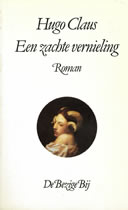Hugo Claus
Mild destruction (Een zachte vernieling)
As in so much of his writing Hugo Claus incorporated autobiographical details in Een zachte vernieling (Mild Destruction), set in Paris in 1950, when, a young man in his early twenties, Claus there. After the Second World War Paris was a Mecca for artists and Claus soon came into contact with the CoBrA group painters Karel Appel among them, as well as the Dutch poets Remco Campert, Rudy Kousbroek, Hans Andreus and Lucebert, and the extravagant Simon Vinkenoog, the central figure of the group. They lived a hand-to-mouth existence, but relished being able to be immersed in the ambience of newly-won freedom and uncontainable creativity.
In the novel, André Maertens, the director of a cultural centre somewhere in Flanders, hears of the death of the poet Bernard Waehlens whom Maertens knew in Paris in the fifties. In a lengthy flashback, he mulls over his experiences during that period. He’d been a housepainter in Ghent, when, fascinated by Sabine, the daughter of wealthy parents, he followed her to Paris. She introduced him to artistic circles and his own natural artistic talents developed. They lived an emancipated existence there, but their relationship was undermined by a fatal abortion, a rape, romantic rivalry between Maertens and Waehlens, and Waehlens’s war record. They scarcely realized that they were driving themselves to destruction, driven by their high expectations of life and blinded by it. ‘During that time in Paris, I forgot something, lost something that should have taken the place of what I have now become,’ Maertens admitted resignedly much later.
Claus looks back at the artists, setting them in perspective with a certain irony, even ridicule at their pompous zeal. At the same time he gradually evokes a dramatic undercurrent, which, fed by Waehlens’s death, swells to become a gripping, emotional and gloomy reflection on unfulfilled expectations, evaporated illusions and past loves, and the futility of bourgeois life. Hugo Claus was master at expressing a sober but suggestive, emotionally charged melancholy.
Publisher
De Bezige Bij
Van Miereveldstraat 1
NL - 1071 DW Amsterdam
TEL. +31 20 305 98 10
FAX +31 20 305 98 24
E-mail: [email protected]
Website: www.debezigebij.nl
Rights
Liepman AG
E-mail: [email protected]
Website: www.liepmanagency.com
Publishing details
Een zachte vernieling (1988, 190 pp)

Biography
Hugo Claus (1929-2008) ranks as the most important Flemish writer after the Second World War. In addition to his literary work, he has been active as a painter and a movie maker. In the fifties he belonged to the avant-garde artists who were active in Paris. His wide-ranging oeuvre consists of novels, stories, poems, plays, and film scripts. His masterpiece is Het verdriet van België (The Sorrow of Belgium, 1983), a massive Bildungsroman which takes place against a black page in the history of Belgium: the collaboration with the German occupier. Claus has received many important domestic and foreign prizes, among which, in 1986, the Dutch Literature Prize (Prijs der Nederlandse Letteren), the most important literary honor in the Dutch language. In 1997 he received the Libris Literature Prize for De geruchten (The Rumours).
Website: www.clauscentrum.be
Quotes
“As a sensual author, Claus is difficult to match.”
― Trouw
“Claus’s work is just as broad as the soul is deep.”
― Gerrit Komrij
“Claus enabled me to hear the amazing richness of Dutch, the rampant luxury of the countless registers of our dialects and expressions, the fermenting lingual swamp under the polished glass roof of our Standard Dutch.”
― Erwin Mortier
Category
Genre: fiction
Translations
- Une douce destruction. Lausanne: Éditions de Fallois, L'Age d'Homme, 1988
- En stilla förintelse. Stockholm: Bonniers, 1990
- Una dolça destrucció. Barcelona: Empúries, 2003
- Continued...
